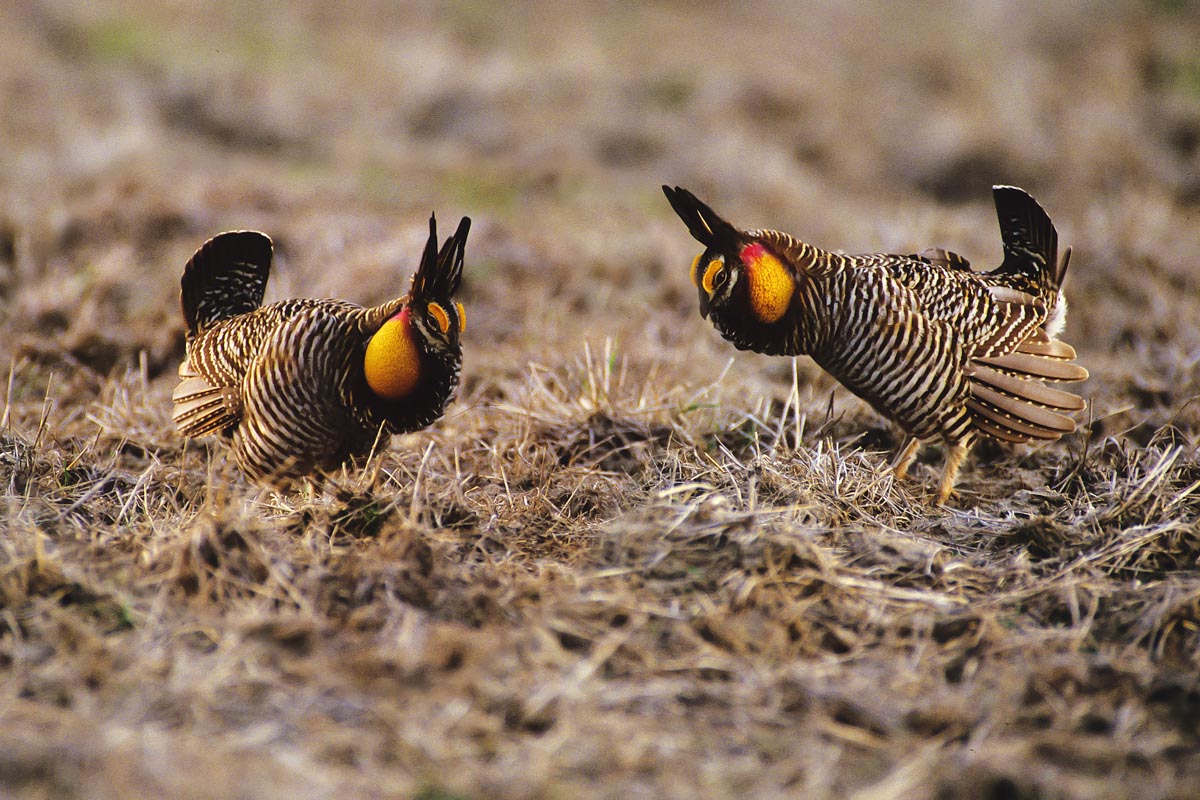
COLORADO SPRINGS, Colo. – Recently published estimates on lesser prairie-chickens from the Western Association of Fish and Wildlife Agencies (WAFWA) indicate good news for the species across its range which includes the states of Colorado, Kansas, Oklahoma, New Mexico, and Texas. The latest lesser prairie-chicken aerial survey from WAFWA shows that bird population estimates remain stable from the previous survey and, more importantly, that the estimated number of birds has increased since surveys began in 2012. These estimates are further bolstered by the detailed ground surveys performed this spring by Colorado Parks and Wildlife.
Colorado’s lesser prairie-chickens are found in the Sand Sagebrush Ecoregion, which includes parts of SE Colorado, SW Kansas, and the Oklahoma Panhandle. Although the estimate from the WAFWA aerial surveys shows a decrease in the Sand Sagebrush Ecoregion, CPW’s higher ground counts in that region indicate that Colorado lesser prairie-chicken numbers have actually increased from the past several years. As reported this spring, CPW estimates that there were over 300 breeding adults in Colorado at the time of the ground surveys.
Why do the numbers look so different? One explanation for the discrepancy in estimates may include a shift in the bird’s distribution and the fact that the aerial surveys no longer cover portions of occupied habitat. Recently, CPW has documented new breeding areas resulting from a translocation effort as well as a natural shift to the north. Survey design also plays a role – the aerial surveys are designed to measure long-term, range-wide trends. For long-term trends, it is important to survey the same areas through time. In addition, the aerial surveys were designed to provide accurate annual estimates for the range-wide population, however, yearly estimates can be quite variable for low-density areas such as the Sand Sagebrush Ecoregion. Biologists often refer to 3-year rolling averages as a way to smooth out this annual variation, and the goal of the surveys was to document trend over 10 years.
In CPW’s surveys, not only did surveyors count more chickens on breeding grounds, known as leks, but they found them in new locations. For example, birds were counted in Prowers County where lesser prairie-chickens haven’t been seen in years, but now appear to be making a comeback. Lekking birds were also found in areas north of known lesser prairie-chicken range, where they’d never been documented before. So what explains this turnaround in chicken numbers and range expansion?
The success of the lesser prairie-chicken in this ecoregion depends on a number of factors, including precipitation, size and the right grass species in the habitat, and solid working partnerships formed between federal and state agencies and private landowners.
Just four years ago, Colorado’s lesser prairie-chickens were on the brink of disappearing from the landscape. Due to a massive blizzard followed by several years of extreme drought, the population had declined to an estimate of 50 lesser prairie-chickens in the state. However, extreme southeast Colorado has experienced four years with relatively good spring and early summer precipitation and overall good annual rainfall. This weather provided suitable bunchgrass nesting cover and increased numbers of insects for prairie-chicken chicks to eat.
While precipitation is a necessary driver in habitat quality for prairie-chickens, there must also be grasslands of sufficient size with the right grass species available to provide suitable habitat. Landowners provide habitat on their rangelands and partner with the U.S. Department of Agriculture (USDA) through the Conservation Reserve Program (CRP). This program helps to conserve soil and water, prevent erosion, and provide wildlife habitat by paying farmers to keep some of their croplands in grassland habitat instead of farm production. CPW also provides funding through the Lesser Prairie-Chicken Habitat Improvement Program for grass establishment, maintenance, and improvement. In southeast Colorado a significant proportion of CRP fields provide lesser prairie-chickens with good habitat on which to live and breed. All eight of the new leks found in 2020 were located on grassland fields enrolled in CRP. The range expansion to the north in Colorado is similar to activity in neighboring Kansas, where lesser prairie-chicken populations are also expanding in the Short-grass/CRP Ecoregion
Another likely driver of the population increase is a four-year conservation project carried out by CPW and partners to provide for a sustainable population in the Sand Sagebrush Ecoregion. From 2016-2019, CPW, Kansas Department of Wildlife, Parks and Tourism (KDWPT), and Kansas State University (KSU) caught over 400 wild lesser prairie-chickens in central Kansas and translocated them to the Comanche and Cimarron National Grasslands in SE Colorado and SW Kansas. In 2016, the population had gotten so low on the Comanche National Grasslands and all of Baca County, Colorado that only one lek with 2 males was observed. This spring, one year after the translocation project was completed, there were 46 males found across 6 new leks in Baca County. CPW and our partners are optimistic about the long-term implications of the new leks in the Sand Sagebrush Ecoregion.
Overall, the spring 2020 lesser prairie-chicken lek counts show that, together with our partners in Kansas, CPW ’s efforts to recover and restore this iconic species to SE Colorado and SW Kansas are working. This video captures the effort and dedication of these partnerships to ensure the future health of the lesser prairie-chicken in Colorado.